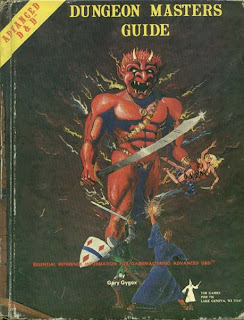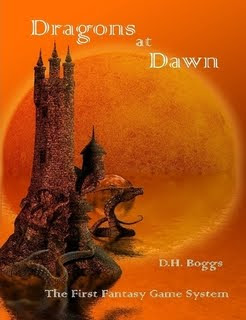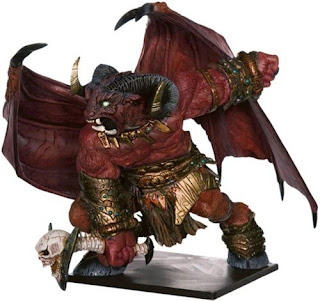Last month I was musing about player-skill, and how I would love to employ a set of combat rules that utilized a player-skill system in some fashion.
When I use the term player-skill system, I mean a method of encounter or event-resolution, that (while not always independent of the rolling of dice) considers such things as the players’ use of strategic resource management, tactical thinking, deduction, information gathering, problem-solving based on common sense, rhetoric, and other types of appropriate in-game persuasion. I intend to cover all of those elements (and any others that come to mind) over the next several weeks, to investigate their application to combat.
The difficulty with applying player-skill to combat is that combat is one of the few systems of any role-playing game where the players demand certainty. Hand-waving, die-roll adjustments for good role-playing, and dialogue-based problem resolution are all well and good, when the only thing at stake is the delay of one 10 minute turn. But when you are talking the life or death of a character, players want to know that the applied combat-resolution system is transparent, even-handed and contains a reasonable measure of statistical predictability.
Are player-skill and combat systems mutually exclusive? Some might argue that the question is moot, since many combat systems seemingly include a player-skill component. After all, if you look at the 4th Edition of Dungeons and Dragons, there is a multiplicity of options for players to choose from, when it comes to choosing combat tactics. Surely the ability to pre-select from a host of feats, and then apply the appropriate feat in the right circumstance, is evidence of the application of player-skill.
I would argue that most games that use those combat feat systems cannot be characterized as player-skill based. Certainly, the player has selected the skills they intend to employ. But that approach to game-play is, in fact, based on system-mastery, not player skill. Players utilizing system-mastery rely on an understanding of how the game system works, using that meta-knowledge to maximize in-game success. The feats in those combat systems are by and large wholly artificial: a fresh player would not be able to use deduction or common sense, based on their understanding of real world physics, common sense or historical tactics, to intuit the most appropriate feat to apply in a combat situation. They would need to understand the relationships between their artificially constructed feats and those of other players in order to take advantage of the designed synergies … system-mastery.
Earlier, I opined that a good player-skill combat system might look a lot like a game of poker. I said this because, in my opinion, poker is a game where, over time, it is not the player who is dealt the best cards that wins, but the one who uses her observational, rhetorical, tactical and strategic skills to outlast and out-bluff her opponents. As the song goes, “you gotta know when to hold ‘em, know when to fold ‘em, know when to walk away, know when to run.”
Resource management (poker chips) is a critical component in the success of a poker player. In the same way, resource management is a critical component of success for D&D players, particularly when it comes to combat. Whether the resource be spells, hit points, arrows, light sources, or what have you, player-skill can be demonstrated in the conservation and judicious and novel use of resources in combat.
Most of you may not be familiar with the combat system utilized in the Lord of the Rings Strategy Battle Game (LOTR:SBG), released by Games Workshop. For some it is because you are not interested in Lord of the Rings milieu itself. Others prefer role-playing and have little interest in table-top battlegames. Others may have heard that the system is simplistic and so never investigated it.
While the system is simpler than, say Games Workshop’s Warhammer, LOTR:SBG has some interesting and elegant design features (and more importantly, character resource management features) that provide interesting talking points regarding resource management.
While my rulebook for LOTR:SBG is 240 pages, the basic rules themselves represent only about 50 of those pages. The rest of the book is filled with painting guides, advanced rules (such as sieges, banners and optional rules), combat scenarios, and photos of various combatants and monsters in miniature (and their related game statistics).
I offer you the following primer on the combat system for LOTR:SBG. Each combatant has a set of combat attributes:
Fighting Skill – think of this as similar to levels in D&D, divorced from extra hit points and other benefits of increased levels. The better your fighting skill, the better your chance of winning a combat. LOTR:SBG uses an opposed-rolls combat system, based on six-sided dice, with the combatants rolling simultaneously, and the higher of the two opposed-rolls winning the contest. In the event of a tie (which happens roughly 17% of the time), the character with the higher fighting skill wins the combat. Therefore, all other things being equal, (see number of attacks, below, for situations where the combat is not equal) a warrior with a higher fighting skill has a 57% chance of winning a combat, while his opponent has a 43% chance. Put another way, in any fight between two otherwise-equal combatants, the warrior with the higher fighting skill will prevail in 3 out of every 5 contests.
Strength and Defence – roughly analogous to the Strength attribute and Armor Class of Dungeons and Dragons. Strength represents how forceful your attack is, with more massive and stronger opponents having higher strength scores than smaller and weaker ones. LOTR:SBG’s defence score represents both the fleetness-of-foot and protective armor of a warrior. In LOTR:SBG, the higher your strength, the more likely you are to inflict wounds if you win a combat (based on the above-mentioned opposed-roll combat system). A high defence improves your likelihood of avoiding that wound, in the event you lose a combat The strength of the winner and defence of the loser are compared to a wound probability matrix, from which the related wound probability is determined. The winner rolls to see if she can meet or exceed that probability, and if so, she inflicts a wound on the loser.
Number of Attacks: in LOTR:SBG, number of attacks works in conjunction with fighting skill. Experienced warriors will often have a higher fighting skill as well as a higher number of attacks, improving both their chance of winning a battle, and subsequently inflicting multiple wounds on the loser. A higher number of attacks translates into a larger dice-pool of six-sided dice (utilized in the previously-described opposed-rolls combat system). A warrior with three attacks would roll three dice using that combat system, while a warrior with one attack would roll one die. When rolling multiple dice based on the number of attacks, only the highest digit that player rolls is used to determine whether they win the combat. So the combatant with the higher number of attacks has a better probability of rolling high.
For example, a warrior with one attack has a 17% chance of scoring a 6, while a warrior with three attacks has a 42% chance of scoring a 6 (on any one of those three dice). Conversely, a warrior with one attack has a 17% chance of scoring a one, while the warrior with three dice has only a 1% chance of scoring a one (on all three dice).
The combat victor also rolls the same number of dice to determine wounds. Therefore, a successful combatant with three attacks could score as many as three wounds on the loser.
Wounds: this represents the number of hits a warrior can take before being eliminated from the battle. Each combatant in LOTR:SBG has a certain number of wounds. Most rank-and-file warriors and rabble can take only one wound, while heroes and monsters will have several wounds.
Courage: this attribute represents bravery and determination. In LOTR:SBG it is used to determine whether a character will stay in the battle, the same way Morale checks are used in old-school D&D. The difference is that in LOTR:SBG, courage (Morale) checks are applied to one’s heroes, not only to ones’ hirelings and henchmen, and the opposing monsters. In LOTR:SBG, having an improved courage score is important, as not only does it keep you in the battle, but it also allows you to rally your followers.
Taken by themselves, the above LOTR:SBG attributes result in a largely character-skill based combat system. The above attributes only affect dice rolls.
The way the strategic resource management portion of LOTR:SBG is revealed is in the following three additional heroic attributes: Might, Will and Fate.
Might: this attribute is a measure of the heroes’ ability to perform unusual and encounter-altering actions. Similar to “bennies” in Savage Worlds, or luck points in other game systems, in LOTR:SBG, Might allows you to attempt special heroic actions (such as pre-empting others in the already-established initiative order, altering an archery die-roll, adjusting a combat or wounds roll, engaging in pre-emptive archery attacks, making additional moves, adjusting “saving throws” and courage checks, or hewing through your current opponents so as to join a second combat). Every hero in LOTR:SBG has a limited number of might points that can be spent during a game.
The player’s decision about when and how to use her might points, is the player-skill portion of the LOTR:SBG system. Do you use the might points early, to score an extra wound or two, or do you save the might points, to be used later in the encounter, when it will decisively swing the tide of battle? The use of the might points becomes a resource management, as well as strategic decision, which reveals the player’s skill in applying those precious might points at the right time, to favourably affect the course of the adventure.
Will: this represents the ability of the possessor to persevere in the face of challenges and setbacks, and use and resist the effects of spells. In LOTR:SBG, Will is used to alter courage checks, in addition to casting and resisting spells. In comparison, in Dungeons and Dragons, spell resistance is applied via a saving throw. I like the idea of will, as used in LOTR:SBG, as it has some interesting sword & sorcery rpg implications: characters with low will-points will eventually succumb to the domination of an evil sorcerer, once their will-points are exhausted from resisting his spells. In addition, will is used by Wizards to cast spells, and for opposing characters to resist the effects of those spells.
In terms of resource management, similar comments apply to will as apply to might: do you use a point of will to cast a spell, or to ensure you pass your courage test, or resist the spell of another wizard, or do you save those will points until your need is dire?
Fate: this is the last LOTR:SBG heroic ability, and represents the ability of the individual to cheat death, or otherwise avoid some unpleasant fate. I like this particular feature of LOTR:SBG and would relish its application to a role-playing game. Instead of taking a wound, a hero can exhaust one of his fate points, and therefore avoid taking actual damage.
I have frequently expressed my dislike for the single mechanic of hit-points, as I disagree with the notion that the ‘luck’ or ‘skill’ portion of hit-points should be recovered at the same rate as actual wounds. I much prefer the idea that hit-points be separated out into wounds and fate, with wounds taking time to heal, while fate can be restored after, say, a good night’s sleep.
Fate is the attribute least affected by resource management issues. A player is probably wise to use those fate points immediately, rather than taking the wound, regardless of your current situation.
Even though LOTR:SBG has a very unambiguous character-skill based combat system, the introduction of Might, Will and (to a lesser degree) Fate provides an opportunity for the players to make strategic resource management decisions, to alter the outcome of a combat. Even though the MWF rules are tightly structured, player-skill is still evident in the timing of the use of those heroic attributes.
 I suppose if you are going to be castrated, it may as well be by Shardra the Castrator, an Amazon bandit from the pages of The Runes of Doom, the third in the Arduin Grimoire series of fantasy RPG supplements.
I suppose if you are going to be castrated, it may as well be by Shardra the Castrator, an Amazon bandit from the pages of The Runes of Doom, the third in the Arduin Grimoire series of fantasy RPG supplements.






